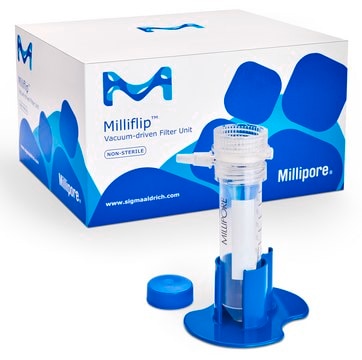SCNY00040
Millipore® Steriflip® Vacuum Tube Top Filter
pore size 40.0 μm, Nylon membrane (net), funnel capacity 50 mL, pack of 25 ea
Synonym(s):
Steriflip® Nylon Net Sterile Centrifuge Tube Top Filter Unit, tube top sterile filter unit, tube top vacuum filter, tube top vacuum sterile filtering unit
About This Item
Recommended Products
material
Nylon membrane (net)
acrylic housing
polypropylene
Quality Level
sterility
sterile
product line
Steriflip®
feature
holdup volume 0.6 mL
hydrophilic
packaging
pack of 25 ea
parameter
45 °C max. temp.
technique(s)
sterile filtration: suitable
H
138 mm
diam.
6.4 cm
filter diam.
4 cm
filtration area
7 cm2
funnel capacity
50 mL
pore size
40.0 μm pore size
fitting
double lead thread inlet (with vacuum port)
double lead thread outlet for 50 mL centrifuge tube
shipped in
ambient
Related Categories
General description
The Steriflip filter unit is designed to work with standard 50 mL centrifuge tubes, which eliminates sample transfer. To filter, just attach the unit to a 50 mL centrifuge tube containing your sample, flip it over, and apply the vacuum. When finished, the filtrate collects in the attached 50 mL centrifuge tube.
New pore sizes ideal for Cell Isolation applications
Steriflip Nylon Net filters are now available in 40, 60 and 100 µm pore sizes, making them ideal for stem cell, cardiomyocite, neurological and skeletal tissue applications. The vacuum-assisted, closed system option ensures sample sterility while enabling faster separation of large volumes of cellular material and improved recoveries.
The Steriflip® filter unit eliminates messy pouring during sample transfer. Directly attach the unit to a 50 mL centrifuge tube containing your sample, flip it over, and apply vacuum. The filtrate collects in the attached 50 mL centrifuge tube. Steriflip filters come in different pore sizes that are ideal for cell isolation. These include nylon net filters in 40, 60 and 100 µm pore sizes, which are ideal for stem cell, cardiomyocyte, neurological and skeletal tissue applications. The vacuum-assisted, closed system ensures sample sterility while enabling fast separation of large volumes of cellular material for efficient recoveries.
Features & Benefits
•Eliminates messy sample transfer via a simple vacuum-assisted, closed system
•Isolate cells from cellular debris using any of the various pore-sized nylon net filters
•Ideal for sterilizing small batches of culture media
•Attaches to any standard 50 mL centrifuge tube, eliminating unnecesary materials, time and risk of spillage
Applications
Sterilization of Aqueous Solutions (up to 50 mL), Sterile Filtration of Small Batches of Culture Media, Sterile Filtration of Buffers with High Value Protein or Small Molecule Components, Cell Isolation
Application
Sterile, 50 mL process volume, 40.0 µm pore size, hydrophilic nylon net membrane, radio-sterilized
Principle
Physical form
Preparation Note
Gamma irradiation
Legal Information
Not finding the right product?
Try our Product Selector Tool.
Certificates of Analysis (COA)
Search for Certificates of Analysis (COA) by entering the products Lot/Batch Number. Lot and Batch Numbers can be found on a product’s label following the words ‘Lot’ or ‘Batch’.
Already Own This Product?
Find documentation for the products that you have recently purchased in the Document Library.
Customers Also Viewed
Articles
Organoid culture products to generate tissue and stem cell derived 3D brain, intestinal, gut, lung and cancer tumor organoid models.
Our team of scientists has experience in all areas of research including Life Science, Material Science, Chemical Synthesis, Chromatography, Analytical and many others.
Contact Technical Service







